Bird feeders are essential for attracting birds to your garden, offering a convenient way to observe wildlife․ With free PDF plans available, you can easily create your own bird feeder using simple materials and tools, making it a fun DIY project for all skill levels․
Types of Bird Feeders
Bird feeders come in various styles, including platform, hopper, tube, suet, and DIY recycled material designs․ These types cater to different bird species and feeding preferences․
2․1 Platform Feeders
Platform feeders are simple, open designs that resemble trays, offering easy access to bird seed․ They are typically flat with raised edges to contain the feed and often have a roof for weather protection․ These feeders are great for ground-dwelling birds like cardinals and doves․ They can be placed on the ground or elevated on poles, depending on the design․ Many free PDF plans for platform feeders include detailed instructions, making them a popular choice for DIY enthusiasts․ The open nature of these feeders allows for easy refilling and cleaning․ Additionally, they can be constructed from various materials, such as wood or recycled plastic, making them versatile and eco-friendly․
2․2 Hopper Feeders
Hopper feeders are a popular choice due to their unique design, which features a central container that holds bird seed․ The seed flows down into a tray as birds consume it, making refills less frequent․ These feeders often include a roof for weather protection and perches for birds to land on while feeding․ They are ideal for attracting smaller bird species, such as finches and sparrows․ Many free PDF plans for hopper feeders provide detailed instructions, including material lists and measurements․ The design is versatile, allowing for customization in size and material choice․ Hopper feeders are both functional and visually appealing, making them a great addition to any backyard bird-watching setup․
2․3 Tube Feeders
Tube feeders are sleek, cylindrical designs that hold seed within a transparent tube, allowing birds to feed through multiple ports․ They are easy to clean and maintain, making them a practical choice for backyard birding․ These feeders are particularly popular for attracting small bird species like finches and chickadees․ Many free PDF plans are available online, offering step-by-step guides to build tube feeders using materials like plastic or metal․ They often feature adjustable perches and removable parts for easy refilling․ Tube feeders are space-efficient and can be hung from trees, providing a clear view of the birds․ Their simple design makes them a great DIY project for beginners, while their functionality ensures they remain a favorite among bird enthusiasts․
2․4 Suet Feeders
Suet feeders are specialized to offer high-energy suet cakes, ideal for attracting woodpeckers, nuthatches, and chickadees․ They typically feature a cage-like design with compartments to hold the suet, often made of metal or plastic․ Many free PDF plans provide instructions for building suet feeders, using simple materials like wire mesh or recycled plastic containers․ These feeders are easy to assemble and require minimal maintenance․ They are particularly beneficial during colder months when birds need extra energy․ Suet feeders can be hung from trees or mounted on poles, ensuring easy access for birds․ Their compact size makes them a great addition to any garden, offering a focused way to support specific bird species while enhancing your outdoor space with a functional and eco-friendly design․
2․5 DIY Recycled Material Feeders
DIY recycled material feeders are an eco-friendly and creative way to attract birds to your garden․ Using items like plastic bottles, cardboard tubes, or old wooden containers, you can craft unique feeders that reduce waste․ Many free PDF plans offer step-by-step guides for repurposing everyday materials into functional bird feeders․ These projects are budget-friendly and often require minimal tools, making them accessible to all skill levels․ Additionally, they serve as an educational opportunity to teach children about recycling and wildlife conservation․ With simple designs and adaptable materials, recycled feeders are a perfect blend of sustainability and bird-friendly functionality․ They can be customized to fit various bird species, ensuring a welcoming space for birds while promoting environmental awareness․
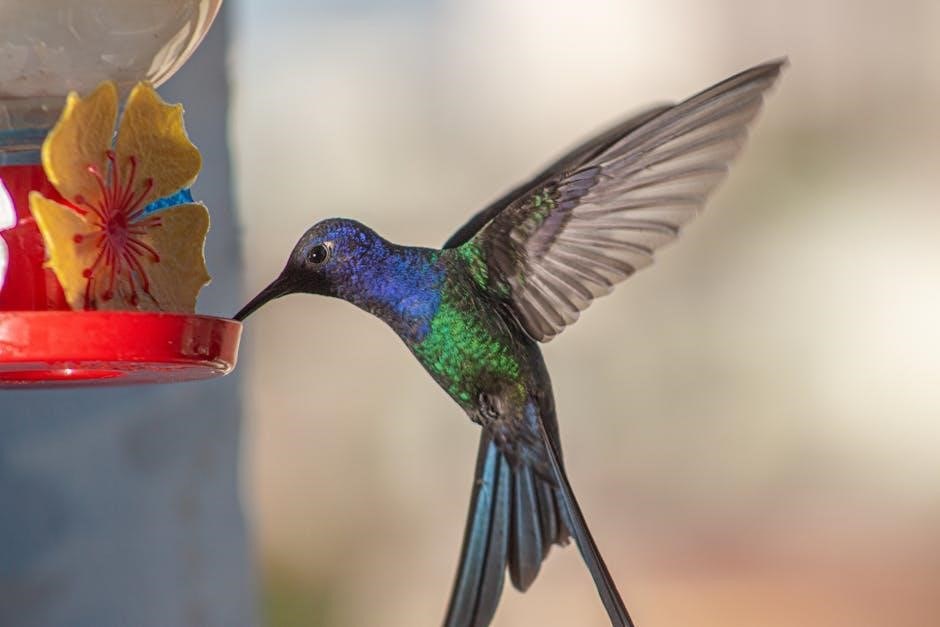
Benefits of DIY Bird Feeders
Creating bird feeders through DIY projects offers numerous benefits, including cost-effectiveness and customization․ By using free PDF plans, you can design a feeder that suits your yard and attracts specific bird species․ DIY feeders allow you to choose materials, ensuring durability and eco-friendliness․ They also provide an engaging activity for families and a learning opportunity for children about wildlife conservation․ Additionally, building your own feeder fosters a sense of accomplishment and connection to nature․ With customizable designs, you can enhance your garden’s aesthetics while supporting local bird populations․ This hands-on approach promotes sustainability and provides a rewarding way to interact with nature, making it a fulfilling hobby for bird enthusiasts of all ages․ DIY bird feeders are a practical and enjoyable way to create a welcoming environment for birds and enhance your outdoor space․
Essential Materials for Bird Feeders
Wood, metal, and plastic are common materials for bird feeders, with cedar being durable and rot-resistant․ Recycled materials like bottles or containers are also popular for eco-friendly designs․
4․1 Wood
Wood is a popular material for bird feeders due to its durability and natural aesthetic appeal․ Cedar, pine, and other softwoods are commonly used, with cedar being particularly favored for its resistance to rot and insects․ Wood feeders can be stained or painted to enhance their appearance, making them a stylish addition to any garden․ Easy to work with, wood allows for intricate designs and customization․ However, it’s important to use untreated wood to avoid harming the birds․ Regular maintenance, such as sealing or refinishing, is recommended to extend the lifespan of wooden feeders․ Wood remains a top choice for DIY bird feeder plans, offering a classic look that blends seamlessly with outdoor environments while providing a sturdy structure for feeding birds․
4․2 Metal
Metal is a durable and long-lasting material for bird feeders, offering excellent resistance to pests and harsh weather conditions․ Stainless steel and aluminum are popular choices due to their strength and rust-resistant properties․ Metal feeders are often sleek and modern, adding a contemporary touch to gardens․ They can be hung from trees or mounted on poles, providing easy access for birds․ While metal can be more expensive than wood, its low-maintenance requirements make it a cost-effective option over time․ Additionally, metal feeders are easy to clean and sanitize, which helps prevent the spread of diseases among birds․ With proper care, metal bird feeders can last for many years, making them a practical choice for outdoor use․ They are also versatile, suitable for various bird species and seed types․
4․3 Plastic
Plastic is a popular material for bird feeders due to its lightweight and weather-resistant properties․ It is easy to clean and maintain, making it a practical choice for outdoor use․ Plastic bird feeders are often affordable and come in a variety of styles, from simple tube feeders to more intricate designs․ They are also durable, withstanding harsh weather conditions like rain and snow․ Many plastic feeders are designed with convenient features, such as easy-fill openings and removable parts for cleaning․ Additionally, plastic feeders are less prone to pest damage compared to wood․ However, it’s important to choose BPA-free and UV-stabilized plastics to ensure longevity and safety for the birds․ Overall, plastic bird feeders offer a balance of affordability, ease of use, and durability, making them a great option for many bird enthusiasts․ They are also widely available in both DIY plans and pre-made designs․
4․4 Recycled Materials
Using recycled materials for bird feeders is an eco-friendly and creative way to support wildlife while reducing waste․ Many DIY bird feeder plans incorporate reused items like plastic bottles, old pallets, or fences․ These materials are often readily available and inexpensive, making the project budget-friendly․ For instance, a plastic bottle can be transformed into a simple hanging feeder by cutting out a few holes and filling it with seed․ Additionally, using recycled materials teaches kids about environmental conservation and sustainability․ This approach also adds a unique charm to your garden, as each feeder can have a personalized touch․ With a little creativity, recycled materials can create functional and attractive bird feeders that benefit both birds and the environment․ This method encourages upcycling and makes DIY projects more accessible to everyone․
Tools Needed for Construction
Essential tools include a hammer, screwdriver, saw, drill, and sandpaper․ Measuring tape and clamps are also useful for precise cuts and assembly․ Safety gear like gloves and goggles is recommended․
5․1 Power Tools
Power tools are indispensable for efficient bird feeder construction․ A drill is essential for making holes and driving screws, while a circular saw or jigsaw is ideal for cutting wood accurately․ A sander ensures smooth surfaces, preventing splinters and improving finish․ For more intricate designs, a router or Dremel tool can be useful․ An impact driver is handy for tighter spaces and heavy-duty fastening․ These tools streamline the process, allowing for precise cuts and assemblies․ Always wear safety goggles and maintain tools properly for optimal performance and longevity․ By incorporating these power tools, you can achieve professional-grade results in your DIY bird feeder project․
5․2 Hand Tools
Hand tools are equally important for bird feeder construction, complementing power tools with precision and control․ A hammer is essential for tapping pieces into place, while screwdrivers (both flathead and Phillips) handle hardware assembly․ A tape measure ensures accurate cuts and fittings, and a utility knife or hand saw can be used for smaller, detailed cuts․ Pliers and wrenches are handy for tightening bolts or gripping small parts․ Clamps are crucial for holding pieces steady during assembly, preventing movement and ensuring proper alignment․ A pencil and marker are used for marking cuts and designs․ These tools provide the finesse and versatility needed for intricate tasks, making them indispensable for a successful DIY bird feeder project․
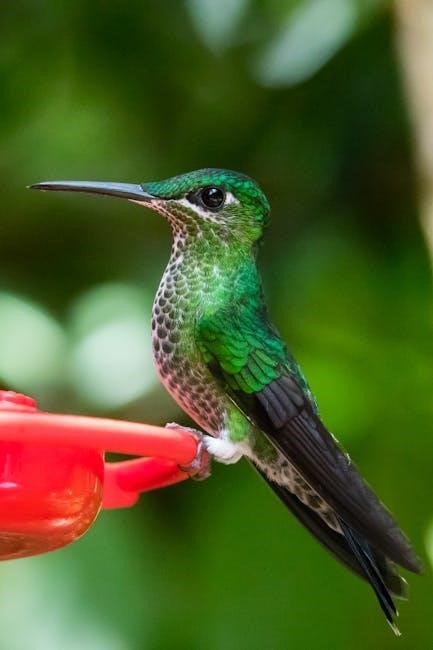
Step-by-Step Construction Guide
Building a bird feeder involves a systematic approach to ensure functionality and durability․ Begin by gathering all materials and tools, following the plan’s specifications․ Start with the base, cutting the wood to the required size and pre-drilling holes for screws․ Assemble the walls and attach them to the base using weather-resistant screws․ Install the roof, ensuring it is angled to allow water runoff․ Add feeding trays and perches, positioning them for easy bird access․ Sand all surfaces to smooth edges and splinters․ Apply paint or sealant for protection, ensuring it’s non-toxic․ Finally, attach a hanging mechanism like a rope or chain․ Follow the plan’s detailed instructions for precise measurements and assembly, ensuring your feeder is both attractive and functional for the birds․
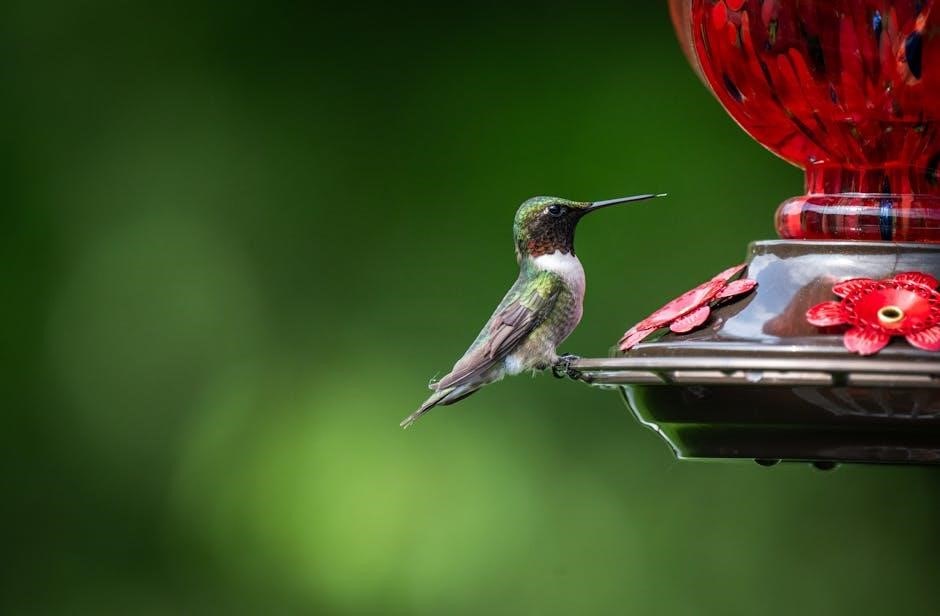
Design Considerations
Effective bird feeder designs prioritize functionality and bird safety․ Consider size, shape, and roof styles to ensure easy access for birds while protecting seed from weather․ Drainage is crucial․
7․1 Size
The size of your bird feeder plays a crucial role in its functionality and appeal․ A feeder that is too small may not hold enough seed, requiring frequent refills, while one that is too large can become cumbersome and difficult to maintain․ Optimal size ensures the feeder is easy to clean and refill, while also accommodating the number of birds you wish to attract․ Many free PDF plans offer adjustable designs, allowing you to customize the size based on your specific needs and the type of birds you are targeting․ Proper sizing also helps in managing seed distribution efficiently, ensuring that birds can feed comfortably without overcrowding․ By selecting the right size, you can create a feeder that is both practical and inviting for your feathered visitors․
7․2 Shape
The shape of a bird feeder significantly impacts its functionality and appeal․ Different shapes, such as tubular, hopper, or platform designs, cater to various bird species and feeding styles․ Tubular feeders are ideal for small birds like finches, while hopper feeders work well for larger birds․ Platform feeders offer an open space, attracting ground-dwelling birds․ The shape also influences seed distribution and ease of cleaning․ For example, a wide-mouth design simplifies refilling and maintenance․ When choosing a shape, consider the types of birds you want to attract and the placement in your garden․ Unique shapes can also add aesthetic value, making your feeder a decorative element․ Ensure the design aligns with your bird-watching goals and personal style for an optimal feeding experience․
7․3 Roof
A roof is a crucial feature of bird feeders, providing protection from rain and snow․ It ensures seeds remain dry and edible for birds․ Sloped or angled roofs are ideal as they prevent water accumulation․ Materials like wood or plastic are commonly used, with waterproof finishes recommended․ The roof’s design should allow easy access for refilling while keeping seeds sheltered․ Additionally, it shields the feeder from direct sunlight, preserving seed quality․ When building, ensure the roof is durable and securely attached to withstand various weather conditions․ A well-designed roof enhances the functionality and longevity of the feeder, creating a welcoming habitat for birds year-round․ Proper construction ensures your feeder remains a reliable food source, regardless of the season or weather․
7․4 Drainage
Proper drainage is essential for maintaining a bird feeder, as it prevents mold and keeps seeds dry․ Incorporating drainage holes in the design ensures water drains efficiently, protecting the seed from moisture․ Typically, holes are placed at the bottom or along the sides of the feeder․ When building, consider the size and number of holes to ensure adequate drainage without spilling seeds․ Materials like plastic or metal often have built-in drainage features, while wooden feeders may require manual drilling․ Regular cleaning and maintenance of the drainage system are crucial to prevent clogs and keep the feeder functional․ A well-designed drainage system enhances the feeder’s durability and ensures birds have access to fresh, dry food year-round, making it a vital component of any bird feeder plan․
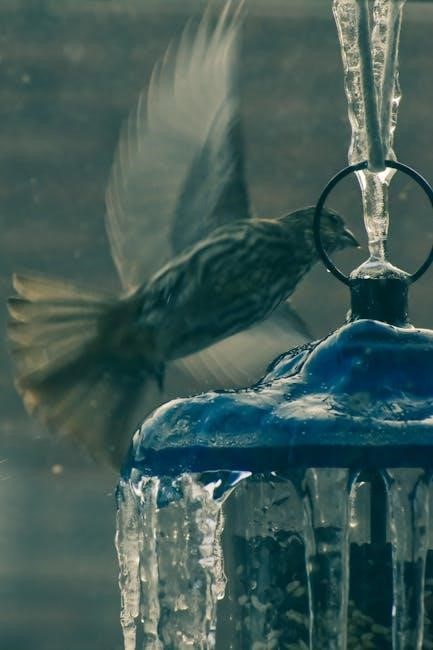
Decorating and Customizing
Decorating and customizing bird feeders adds a personal touch and enhances their appeal․ Using materials like paint, carvings, or recycled items allows for unique designs․ Themes such as rustic, modern, or seasonal styles can match your garden aesthetics․ Adding features like roof embellishments or decorative perches can attract specific bird species․ Personalization also extends to functionality, such as incorporating predator guards or weight-activated perches․ DIY enthusiasts often experiment with creative designs, blending artistry with practicality․ Customizing bird feeders not only makes them visually appealing but also creates a welcoming habitat for birds, fostering a deeper connection with nature․ Whether simple or elaborate, personal touches make bird feeders stand out and reflect individual creativity․
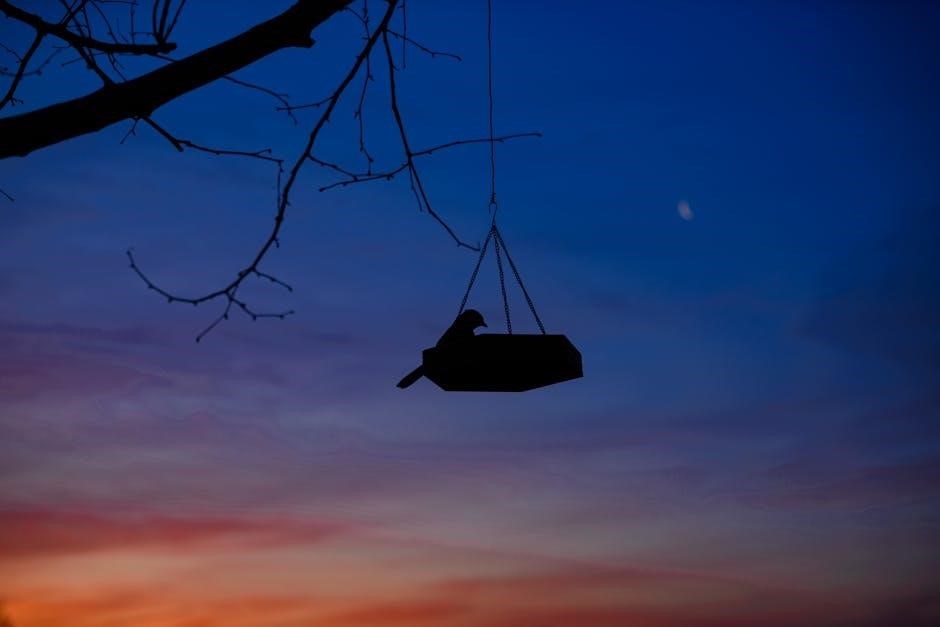
Hanging and Placement
Hanging and placement are crucial for the effectiveness of a bird feeder․ Positioning it in an open area, 3-5 feet above ground, ensures easy access for birds while deterring predators․ Placing feeders near trees or shrubs provides birds with shelter and escape routes․ Visibility is key, so choose a spot where you can easily watch the birds․ Avoid areas with overhead branches to reduce predator risks․ Ensure the feeder is stable and level to prevent seed spillage․ Consider the direction to protect it from harsh winds or direct sunlight․ Proper placement also makes refilling and cleaning easier․ By thoughtfully selecting the location, you create a welcoming and safe environment for birds to thrive․
Maintenance and Upkeep
Regular maintenance is essential to keep your bird feeder clean and functional․ Clean the feeder every 1-2 weeks to remove mold and bacteria, ensuring the health of visiting birds․ Use a mild detergent and rinse thoroughly before refilling with seed․ Check for damage or wear, such as cracked plastic or rusty metal, and repair or replace parts as needed․ Keep the feeding area tidy by sweeping up spilled seeds to prevent attracting pests․ During rainy seasons, ensure the feeder has proper drainage to avoid waterlogged seed․ Store seed in a dry, rodent-proof container to maintain freshness․ By following these simple steps, you can create a safe and welcoming environment for birds while prolonging the life of your feeder․
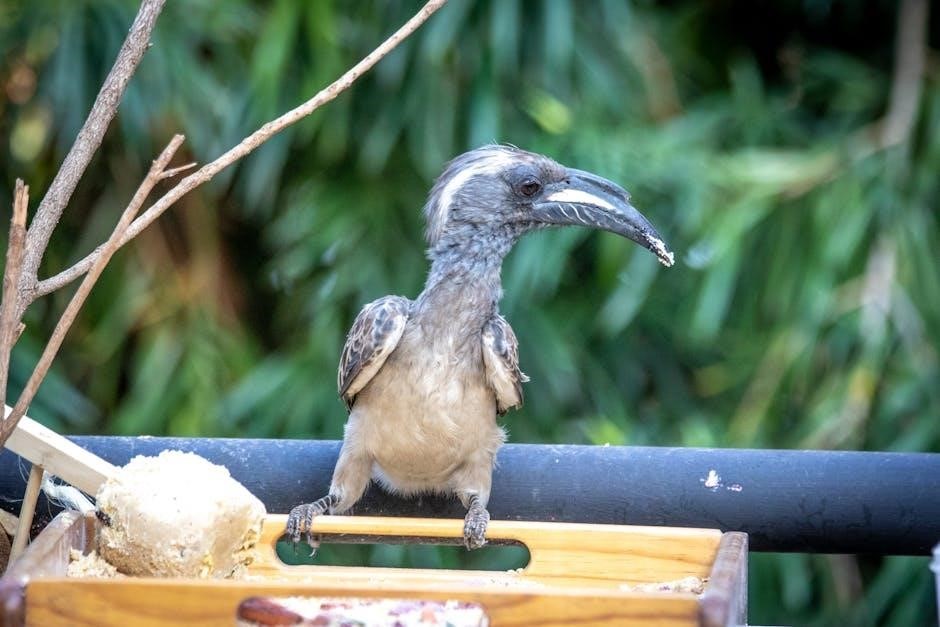
Common Mistakes to Avoid
When building a bird feeder, avoid common mistakes to ensure its functionality and longevity․ One frequent error is improper placement, such as positioning the feeder in overly shaded areas or too close to predator habitats․ Using untreated wood without sealing can lead to rot and decay․ Forgetting to incorporate drainage holes can cause seed to mold, deterring birds․ Additionally, neglecting to add protective features, like predator guards, can result in unwanted visitors․ Using the wrong type of seed for the birds in your area is another oversight․ Finally, failing to perform regular maintenance, such as cleaning and repairing the feeder, can lead to a decline in bird visits․ Avoiding these mistakes ensures your feeder remains effective and attractive to birds․
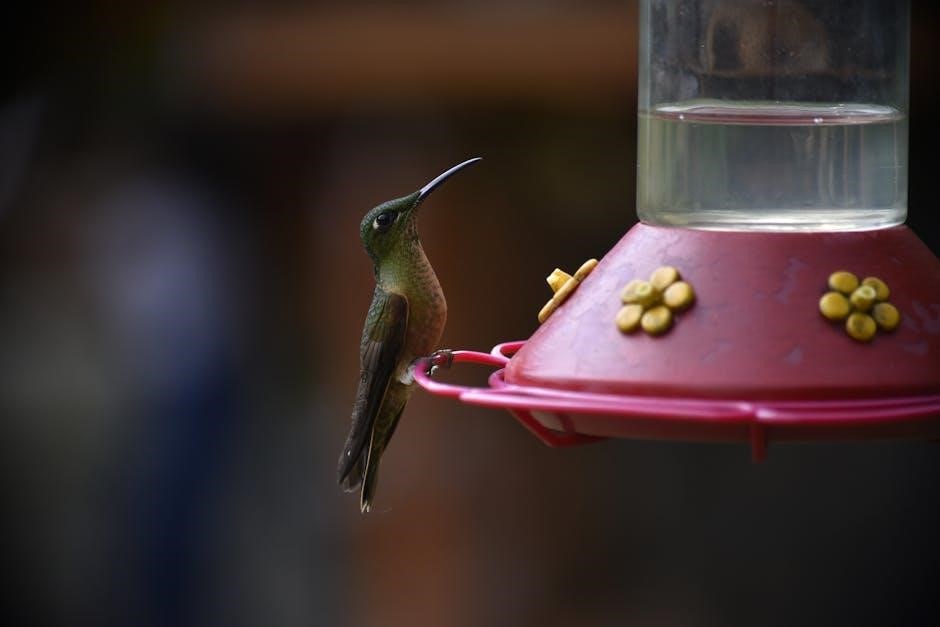
Advanced Features
Enhance your bird feeder with advanced features like weight-activated perches and predator guards․ These additions deter larger birds and predators, ensuring smaller species can feed safely and efficiently․
12․1 Weight-Activated Perches
Weight-activated perches are a clever feature that enhances bird feeder efficiency․ These perches are designed to collapse or shut off access under the weight of larger birds or predators, allowing smaller species to feed peacefully․ By incorporating this mechanism, you ensure that only desired birds can access the seed, reducing competition and waste․ Many free PDF plans include detailed instructions for adding this feature, often requiring minimal additional materials like springs or hinges․ This simple yet effective innovation makes your bird feeder more user-friendly for the birds you want to attract, while keeping unwanted visitors away․ It’s a great way to customize your feeder for optimal performance and bird enjoyment․
12․2 Predator Guards
Predator guards are essential additions to bird feeders, designed to protect birds from unwanted visitors like raccoons, squirrels, and other small predators․ These guards typically consist of cages, domes, or weighted mechanisms that allow small birds to feed while preventing larger animals from accessing the seed․ Many free PDF plans include detailed instructions for building predator guards, ensuring your feeder remains a safe haven for birds․ By integrating this feature, you can enjoy watching your feathered friends without worrying about predators disrupting their feeding․ Predator guards are a practical and effective way to enhance the functionality of your DIY bird feeder, making it both bird-friendly and durable․
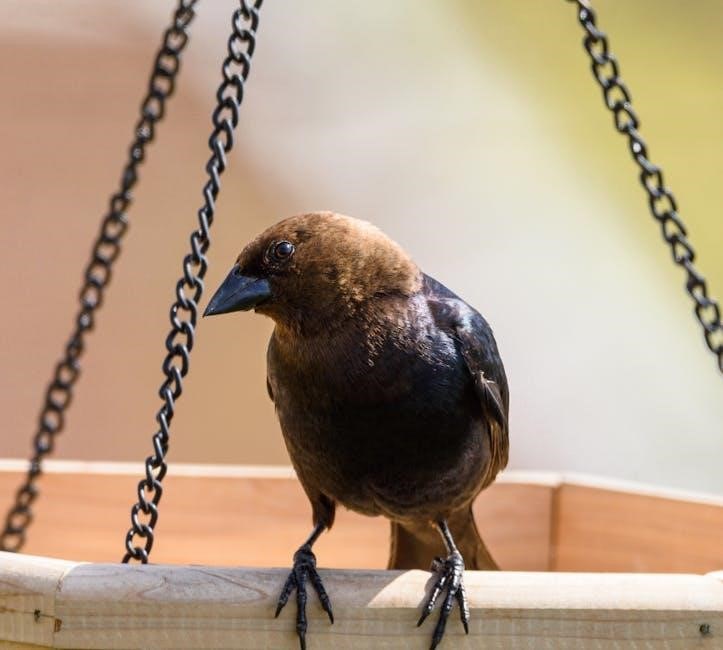
Bird-Friendly Features
Bird-friendly features in feeder designs ensure that birds can safely and effectively use the feeders․ These features include easy cleaning, proper drainage, and smooth surfaces to prevent mold and bacteria growth․ Many free PDF plans incorporate these elements, such as angled roofs to prevent water accumulation and smooth edges to avoid injury to birds․ Additionally, using non-toxic materials and ensuring adequate ventilation are crucial for maintaining a healthy environment for the birds․ By integrating these features, you can create a feeder that not only attracts birds but also supports their well-being․ These thoughtful designs make your DIY bird feeder a welcoming and safe space for your feathered visitors, encouraging them to return frequently;
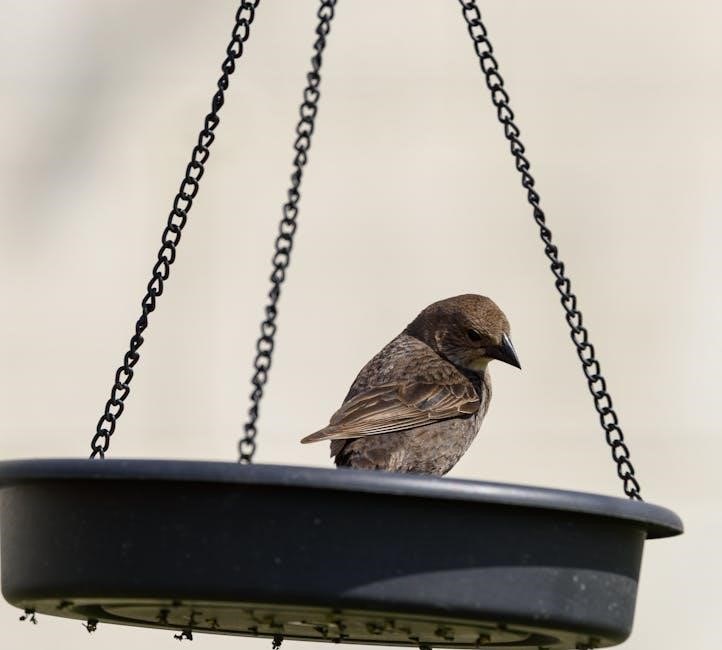
Seasonal Considerations
Seasonal considerations play a significant role in the design and placement of bird feeders․ During winter, feeders should be designed to protect seed from moisture and freezing, while summer designs might focus on ventilation to prevent seed spoilage․ Many free PDF plans offer adaptable designs that can be modified for different seasons, such as adding roofs or drainage systems․ Additionally, the type of bird seed offered may vary by season, with high-energy seeds like suet being more critical in colder months․ Understanding these seasonal needs ensures that your bird feeder remains effective year-round, providing a consistent food source for birds and enhancing their survival during harsh weather conditions․ By tailoring your feeder to seasonal changes, you create a more inviting and supportive environment for wildlife․
Budget and Cost-Effectiveness
Budget and cost-effectiveness are key considerations when building bird feeders․ Many free PDF plans emphasize the use of affordable materials, such as recycled wood or plastic bottles, making DIY projects accessible to everyone․ By utilizing materials you may already have, you can significantly reduce costs․ Simple designs often require minimal tools and time, further lowering expenses․ Additionally, building your own feeder instead of buying one can save money in the long run․ These cost-effective solutions allow you to create a functional and attractive bird feeder without breaking the bank, making birdwatching and wildlife support an affordable hobby for nature enthusiasts of all backgrounds․
Educational Aspect
Bird feeder projects offer a valuable educational experience, especially for children․ Building a feeder from PDF plans teaches woodworking, measurement, and DIY skills․ It also fosters an appreciation for nature and wildlife conservation․ Many plans include educational components, such as tips on bird species and habitat needs․ This hands-on learning opportunity helps kids understand the importance of supporting local bird populations․ Additionally, constructing a feeder can serve as a science project, teaching concepts like eco-friendly practices and sustainability․ Engaging in such activities not only enhances practical skills but also encourages a lifelong interest in environmental stewardship and outdoor activities․ This makes bird feeder projects a rewarding and educational endeavor for families and schools alike․
